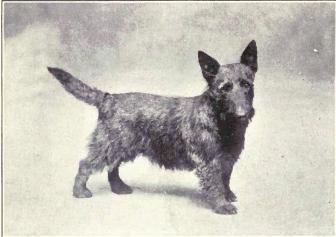
Thought to have been developed in 1700s Scotland, the Scottie or 'Aberdeen Terrier' as it is sometimes known, was primarily bred to flush out den quarry, including rabbit, fox, otter and badger. It is possible that the Scottish Terrier existed much earlier than the 1700s, first appearing in records dating from 1436. Widely utilised on farms to catch vermin and thus protect food and supply stores from sabotage, the Scottie was a popular breed choice for working families in need of a versatile companion dog. Introduced to the United States in the early 1890s, the Scottish Terrier has been found in the White House three times, along with presidents Roosevelt, Eisenhower and Bush. The Scottish Terrier was officially recognised by the AKC in 1885.
A dog of compact size and structure, the Scottish Terrier boasts short legs, a rectangular body, a deep, square-cut muzzle, erect ears and tail, and dark, almond-shaped eyes. The coat is typically dense, with a hard, wiry texture. It is usually observed in colours of solid black, brindle or dark grey, with wheaten varieties being rare. The Scottie usually has a beard, or feathering on the face and muzzle. Despite being distinctive amongst the Terrier breeds, the Scottie is sometimes mistaken for the soft-coated Wheaten Terrier or the West Highland White Terrier. Rustic in appearance and dogged and fearless on the hunt, the Scottie was nicknamed the 'little diehard' in the 19th century, by the Fourth Earl of Dumbarton.
Vigilant to change and threat and highly territorial, the Scottish Terrier makes an excellent watch dog. Otherwise remaining calm, gentle and affectionate, the Scottie is the ideal breed choice for active families, being compatible with children and engaging well in exercise and play. In order to avoid wilful, disobedient or aggressive behaviours, early socialisation, firm leadership and consistent training is important and beneficial. On average, a healthy Scottie at full maturity will weigh 8.5-10 kg, with a life expectancy of 11-13 years.
The Scottish Terrier is susceptible to an array of genetic health complaints, ranging from mild to more serious. These include various optical disorders - cataracts, progressive retinal atrophy and entropion are prevalent in the breed. Besides this, serious neurological problems and brain cancer, deafness, blood disorders and cases of Scottie cramping are seen, as are bladder stones, bladder cancer and issues relating to behaviour and temperament.








From United Kingdom
Our little Pixie is 7 years old now, and she is lovely, calm, lazy and extremely stubborn.
She started to show her age having grey hair all around her eyes and muzzle.
Pixie and Luna (westie) joined our family 4 years ago. Love you girls
From Northamptonshire, United Kingdom
I have 3 Scotties. Mum ,Dad and. Son. Elsie is very bossy and the other 2 have to do what she says. She loves th3 arm of the chair where you will find£ her most days. Angus is the vocal one but is more loving and loves to sleep behind the settee. fergus is nearly 3 and the baby but is much bigger than the other 2 which I put down to having to feed him on formula milk as a baby. H3 has a problem which is skin and doesn’t l8ke you to touch him in places.